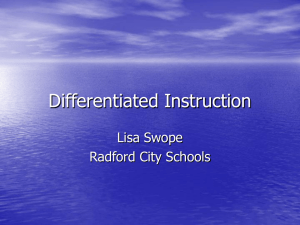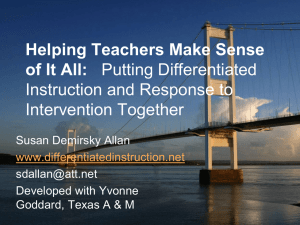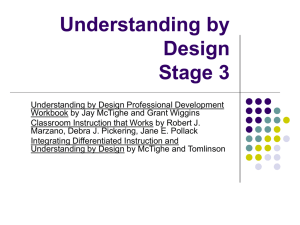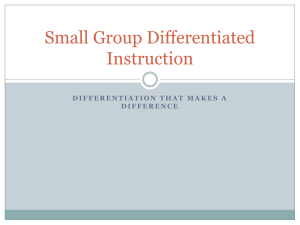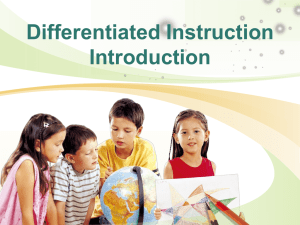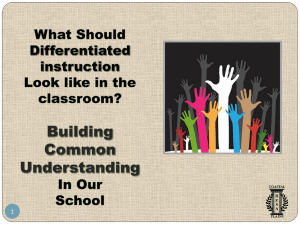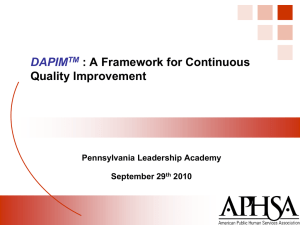Differentiated Instruction: Strategies for Teachers
advertisement
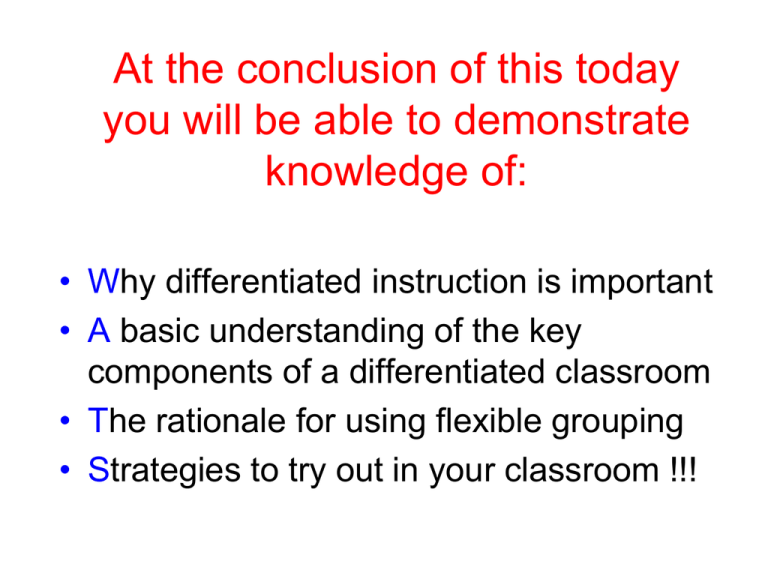
At the conclusion of this today you will be able to demonstrate knowledge of: • Why differentiated instruction is important • A basic understanding of the key components of a differentiated classroom • The rationale for using flexible grouping • Strategies to try out in your classroom !!! Brainstorming Activity 1. What is differentiated instruction? 2. What are the key principles of differentiated instruction? Differentiated Instruction defined… Differentiated instruction is a philosophy that enables teachers to plan strategically in order to reach the needs of the diverse learners in classrooms today. Differentiation is not just a set of instructional tools but a philosophy that a teacher and a professional learning community embrace to reach the unique needs of every learner. -Gregory,2003, p. 27, Differentiated Instructional Strategies in Practice Differentiated Instruction defined… Differentiation can be defined as a way of teaching in which teachers proactively modify curriculum, teaching methods, resources, learning activities, and student products to address the needs of individual students and/or small groups of students to maximize the learning opportunity for each student in the classroom. -Tomlinson et al., (In press) Differentiated Instruction… Provides different avenues to acquiring content, to processing or making sense of ideas, and to developing products so that each student can learn. Tomlinson, 2001 Differentiated Instruction is… “Shaking up” what goes on in the classroom so that students have multiple options for taking in information, making sense of ideas, and expressing what they learn. Tomlinson, 2001 Key Principles of a Differentiated Classroom • Teachers make the difference • Students differ in learning preferences and need multiple and varied avenues to learning • All students can learn what is important for them to learn • Instruction must be meaningful • Curriculum, instruction, and assessment are inseparable • Diversity should be valued and respected • Differentiating and adapting is critical to the success of all learners • Flexibility is the hallmark of a differentiated classroom Key Principles of a Differentiated Classroom • Differentiating instruction and adapting curriculum must become the rule rather than the exception • Goals are maximum growth and continued success • Collaborative planning is essential • Students and teachers are collaborators in learning • Curricular adaptation is neither prescriptive nor precise • Adaptations should maximize student participation in typical curriculum and instruction • Adaptations should maximize student involvement with school peer groups • The teacher understands, appreciates, and builds upon student differences. What is the rationale behind DI? Often viewed as in conflict with many people’s purpose of education. A paradox exists… One one hand Education should focus on teaching standards and all students master basic competencies On the other hand: Education should focus on maximize student capabilities and focuses on the global definition of democracy. “Seeing the Water” However, the dominant paradigm of education today is standards based. This paradigm is historically constructed and firmly entrenched in our schools’ cultures. (i.e., schools have a common set of assumptions, rules, beliefs) “Struggle for Authenticity” • The big challenge is for teachers to become comfortable and confident in their abilities to differentiate instruction during our current era of high stakes accountability. • Simultaneously, educators must find a way to be true to themselves while being honest and practical to their students and at least somewhat agreeable to the powers that be. (Grimmet-Neufeld, 1994) Teacher Roles in a Differentiated Classroom • In a differentiated classroom, the teacher proactively plans and carries out varied approaches to content, process, and product in anticipation of and response to students’ differences in readiness, interest, and learning needs. - Tomlinson, 2001, p. 7 Teacher Roles in a Differentiated Classroom • Teachers must move away from the notion that they dispense information and knowledge and move towards seeing themselves as organizers of learning opportunities. • While content knowledge is essential, teachers in differentiated classrooms focus less on “knowing the correct answers” and more on understanding their students abilities, learning style, and needs. • These teachers create ways to learn that both capture students’ attention and lead to learning. Differentiated Instruction is a teacher’s response to learners’ needs guided by general principles of differentiation such as: respectful tasks clear learning goals ongoing assessment and adjustment flexible grouping positive learning environment Teachers can differentiate: Content Process Product Based on students’ Readiness Interests Learning Profile Flexible Grouping Students are part of many different groups (and also work alone) based on the match of the task to student readiness, interest, or learning style. Teachers may create skills – based or interest – based groups that are heterogeneous or homogeneous in readiness level. Sometimes students select work groups, and sometimes teachers select them. Sometimes student group assignments are purposeful and sometimes random. Flexible Grouping Initially use whole group for instruction Divide group for practice or enrichment Not a permanent arrangement Use for hour, day, week, etc. Planning for Grouping • • • • How does flexible grouping benefit students? When does grouping facilitate instruction? How do you determine group membership? Which activities lend themselves to group work? How does flexible grouping benefit students? • Gives students and teachers a voice in work arrangements. • Allows students to work with a variety of peers. • Keeps students from being “pegged” as advanced or struggling. Group Membership Can be determined by: • Readiness • Interest • Reading Level • Skill Level • Background Knowledge • Social Skills How to determine group membership? Form Teams • Remember – SKILL LEVEL USING FORMATIVE DATA • (H, HM, LM, L) – – – – GENDER ETHNICITY ESOL/ESE DISCIPLINE ISSUES Activities to Use in Groups Cooperative Learning Structures • Structures are tools you can use in your classroom to build community, engage students, and make learning fun • Some example structures are incorporated using: – – – – – Timed Pair Share Rally Robin Round Robin Roundtable Shoulder and face partners TAPS • • • • Total Group Alone Partner Small Group Effective instruction embeds each of these grouping methods into lessons to assist with student learning. Differentiated Instruction is a teacher’s response to learners’ needs guided by general principles of differentiation such as: respectful tasks clear learning goals ongoing assessment and adjustment flexible grouping positive learning environment Teachers can differentiate: Content Process Product Based on students’ Readiness Interests Learning Profile According to students’ Readiness Refers to readiness for a given skill, concept, or way of thinking. Interests and Attitudes Have to do with those things that learners find relevant, fascinating, or worthy of their time. Learning Profile & Need Refer to things such as learning style, intelligence preferences, how the student processes information, and how the learner sees himself in relation to the rest of the world. Readiness A task that’s a good match for student readiness extends that student’s knowledge, understanding, and skills beyond what the student can do independently…it pushes the student beyond their comfort zone and provides support in bridging the gap between the known and unknown. Encourage your students to “work up” - that is, be ready to match students to tasks that will stretch them. Examples include - varied texts, varied scaffolding, supplemental materials. Interests and Attitudes Planning engaging lessons that “hook” students on the topic at hand by: 1. 2. 3. Helping students realize a match between school and their desires Using skills or ideas familiar to students to bridge ideas and skills less familiar to them Enhancing student motivation to learn Examples include - interest centers or groups, exploratory studies (jigsaw, literature circles, webquests, etc.) using different modes of expression (oral, written, design/build, artistic, etc.) Learning Profile Learning profile refers to ways in which we learn best as individuals. Be a student of your students and also help your students understand their own learning preferences. Categories include - learning style preferences, intelligences preferences, culture influenced preferences, gender based preferences. Examples include - varying teacher presentation (auditory, visual, kinesthetic, whole-to-part, part-towhole), multiple modes of assessment Laugh and Graph Awesome Quite Nice I Get By Not So Hot Dismal Learn best with quiet. I need to eat while I learn. I like to act. I learn best by reading. Drawing pictures and diagrams help me to learn. Once I hear the information, I know it. Putting together models and projects helps me to learn. Laugh and Graph Awesome Quite Nice I Get By Not So Hot Dismal Learn best with quiet. I need to eat while I learn. I like to act. I learn best by reading. Drawing pictures and diagrams help me to learn. Once I hear the information, I know it. Putting together models and projects helps me to learn. Differentiated Instruction is a teacher’s response to learners’ needs guided by general principles of differentiation such as: respectful tasks clear learning goals ongoing assessment and adjustment flexible grouping positive learning environment Teachers can differentiate: Content Process Product Based on students’ Readiness Interests Learning Profile Ways to Differentiate: Content: What is taught Process: How it is taught Product: How learning is assessed to Differentiate Content • Reading Partners / Reading Buddies • • • • • • • • • • • • • • • Read/Summarize Read/Question/Answer Visual Organizer/Summarizer Parallel Reading with Teacher Prompt Choral Reading/Antiphonal Reading Flip Books Split Journals (Double Entry – Triple Entry) Books on Tape Highlights on Tape Digests/ “Cliff Notes” Notetaking Organizers Varied Texts Varied Supplementary Materials Highlighted Texts Think-Pair-Share/Preview-Midview-Postview Tomlinson – ‘00 TO DIFFERENTIATE PROCESS • Fun & Games • RAFTs • Cubing, Think Dots • Choices (Intelligences) • Centers • Tiered lessons • Contracts RAFT RAFT is an acronym that stands for Role of the student. What is the student’s role: reporter, observer, eyewitness, object? Audience. Who will be addressed by this raft: the teacher, other students, a parent, people in the community, an editor, another object? Format. What is the best way to present this information: in a letter, an article, a report, a poem, a monologue, a picture, a song? Topic. Who or what is the subject of this writing: a famous mathematician, a prehistoric cave dweller, a reaction to a specific event? RAFT Activities Role Audience Format Topic Semicolon Middle Schoolers Diary entry I Wish You Really Understood Where I Belong N.Y.Times public Op Ed piece How our Language Defines Who We Are Huck Finn Tom Sawyer Note hidden in a tree knot A Few Things You Should Know Rain Drop Future Droplets Advice Column The Beauty of Cycles Lung Owner Owner’s Guide To Maximize Product Life Rain Forest John Q. Citizen Paste Up “Ransom” Note Before It’s Too Late Reporter Public Obituary Hitler is Dead Martin Luther King TV audience of 2010 Speech The Dream Revisited Thomas Jefferson Current Residents of Virginia Full page Newspaper Ad If I Could Talk to You Now Fractions Whole Numbers Petition To Be Considered A Part of the Family A word problem Students in your class Set of Directions How to Get to Know Me Format based on the work of Doug Buehl cited in Teaching Reading in the Content Areas: If Not Me Then Who? Billmeyer and Martin, 1998 to Differentiate Product • Choices based on readiness, interest, and learning profile • Clear expectations • Timelines • Agreements • Product Guides • Rubrics • Evaluation Map Diagram Sculpture Discussion Demonstration Poem Chart Dance Campaign Cassette Quiz Show Banner Brochure Debate Flow Chart Puppet Show Tour Lecture Editorial Painting Costume Blueprint Catalogue Dialogue Newspaper Scrapbook Questionnaire Flag Scrapbook Graph Debate Museum Learning Center Advertisement Book List Calendar Coloring Book Game Research Project TV Show Song Dictionary Film Collection Trial Machine Mural Award Recipe Test Puzzle Model Timeline Article Diary Poster Magazine Photographs Terrarium Petition Drive Prototype Speech Cartoon Biography Review Invention for Interest – Readiness – Learning Profile by Self – Peers - Teachers THINKING ABOUT ON-GOING ASSESSMENT 1. 2. 3. 4. 5. 6. 7. 8. 9. 10. 11. STUDENT DATA SOURCES Journal entry Short answer test Open response test Home learning Notebook Oral response Portfolio entry Exhibition Culminating product Question writing Problem solving TEACHER DATA MECHANISMS 1. Anecdotal records 2. Observation by checklist 3. Skills checklist 4. Class discussion 5. Small group interaction 6. Teacher – student conference 7. Assessment stations 8. Exit cards 9. Problem posing 10. Performance tasks and rubrics Assessment Idea Exit Cards Exit Cards (AKA “Tickets Out The Door”) are used to gather information on student readiness levels, interests, and/or learning profiles. The teacher hands out index cards to students at the end of an instructional sequence or class period. The teacher asks the students to respond to a predetermined prompt on their index cards and then turn them in as they leave the classroom or transition to another subject. The teacher reviews the student responses and separates the cards into instructional groups based on preset criteria. Timed Pair Share • Work with a single partner who is sitting next to you • The person with the most recent birthday will begin and will be “Person A” • Person A will share for one minute while Person B listens respectfully. Person B cannot talk, but can ask a single question if he/she needs clarification. • At the signal, reverse roles. Person B will speak for one minute while Person A listens respectfully. • Topic is: “Share your learning preferences from your laugh graph.” Gambits • Person A, turn to Person B, and say, “Thanks for participating.” • Person B, turn to Person A and say, “Thanks for participating.” Nine Types of Adaptations Input Output Size Time Difficulty Level of Support Degree of Participation Modified Goals Substitute Curriculum Input • Strategies used to facilitate student learning. – – – – – Using highlighted text (Human Highlighter) Using graphic and advance organizers/guided notes Providing audiotapes of textbooks Using amplification Eye Cue/Lend me an Ear National Training Laboratories Bethel, Maine Output • The ways learners demonstrate understanding and knowledge. – Alternative ways to demonstrate mastery (Oral or dictated responses, pictures, role plays, semantic maps or webs, response cards, KWL, Venn diagrams, etc.) – Using highlighted tape – Unless testing reading comprehension, consider reading test items to students or allowing them to read aloud Output Example: Response Cards vs. Traditional Hand Raising Time Used Response Cards Hand Raising 30 minutes 22 responses per child 1.5 responses per child 180 days 3700 270 responses responses per per child child Additionally, ALL students scored higher on the quiz and the end of the unit test. Hewett, Gardner III, Cavanaugh, Courson, Grassi, and Barbetta, Teaching Exceptional Children, 1996. A B C D Response Cards True False Cause Effect + x - Size • The length of an assignment, demonstration or performance learners are expected to complete. – Flexible Folder – Reduce the length of a report, number of math problems, spelling words, etc… Time • The flexible time needed for student learning – Timeline for assignment completion (NAT) – More time for tests – Human Billboard – Do-Due Board Difficulty • The varied skill levels, conceptual levels and processes involved in learning. – Tier the assignment so the outcome is the same but with varying degrees of concreteness and complexity (Think-Tack-Toe) – Use alternative worksheets that require minimal writing – Sequence steps in a task – Break testing into smaller sections over more days Think-Tack-Toe Complete a character analysis for the main character from the story Complete a character report card from the book Name and draw a person who is like one of the characters from the story Build a miniature stage setting from the book Draw a picture describing at least 3 settings from the story Make up a limerick or poem about the setting of the book Use a sequence Write a new chart or timeline to beginning or ending describe at least 7 to the story events from the book Make a board game about the story’s key events Level of Support • The amount of assistance to the learner. – Consider calculators / spell check / times tables charts… think about what you are REALLY assessing – Use of manipulatives, visual aids, peer supports, etc. (Book it) – Reading books provided at a lower level. Degree of Participation • The extent to which the learner is actively involved in tasks. Examples: – Alternative goal within an activity: participating in a small group rather than completing the same task as others Modified Goals • The adapted outcome expectations within the content of a general education curriculum. Examples: – Student focuses more on writing letters and words rather than composing sentences and paragraphs. – Partial completion of SSS/Benchmarks. Substitute Curriculum The significantly differentiated instruction and materials to meet a learner’s identified goals. – Magnet programs and schools – Gifted and Talented Programs – Life Skills Programs for students with multiple and severe disabilities (ESE SSS Standards and Benchmarks) What Research Tells Us Focus on the essentials Use explicit strategies Provide temporary support Make linkages obvious and explicit Prime background knowledge Review for fluency and generalization Pages 9 – 18 Accommodations However, in learning to differentiate, teachers may need help with . . . • • • • • • • • • • A rationale for differentiation Pre-assessing student readiness Effective work with classroom groups Flexible grouping Resolving issues regarding grading / report cards Role of the teacher in a differentiated classroom Appropriate use of varied instructional strategies Using concept-based instruction Develop carefully focused tasks and products Knowing how to teach struggling learners without “remedial expectations” Carol Tomlinson In sum… Differentiation suggests it is feasible to develop classrooms where realities of student variance can be addressed along with curricular realities…It challenges us to draw our best knowledge about teaching and learning. It suggests there is room for both equity and excellence…it is complex. It calls on us to question, change, reflect, and change some more. Tomlinson, 2001, pg. vi But it is important to remember that any method of differentiating instruction must use the FSU principle Or they will not be successful for teachers or students! Even with that said we still realize and know that… the Gators RULE!!!

